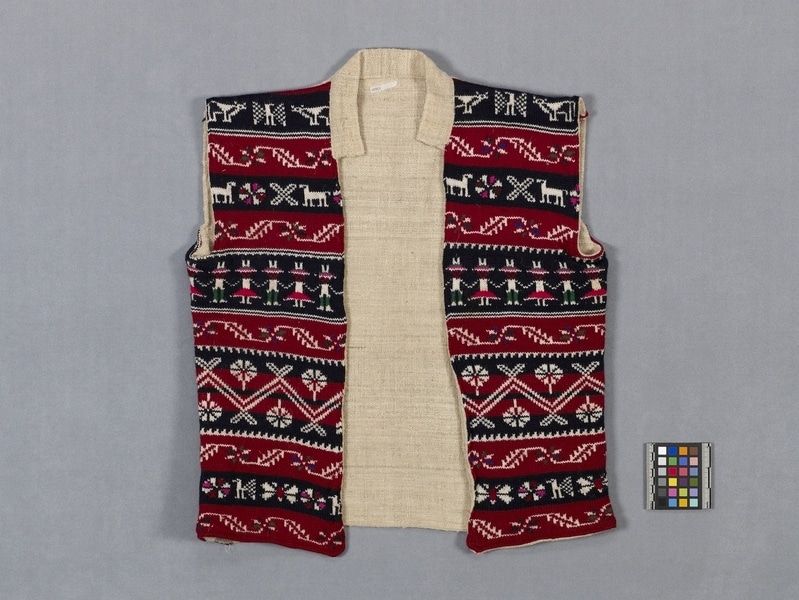Vest Item Number: Sf963 from the MOA: University of British Columbia


Description
Vest with a stand-up collar and knitted front panels with horizontal bands of animal and humanoid figures (men and women holding hands, birds, butterflies, llamas and cows), floral motifs, stepped zigzags, and geometric motifs in off-white, red, pink, blue and green on alternating dark red and dark blue bands.
History Of Use
Bayeta is made by males on the treadle loom and is used for garments that are cut to size and sewn, such as trousers, shirts, skirts and vests. The style, the construction and and the loom used are non-indigenous and derive from Spanish peasant tradition. Handspun sheep's wool is the traditional material, but synthetic yarns are now used. Knitting is a technique introduced by the Spanish and done only by males on Taquile. The knitted vest fronts are a recent innovation which may have been aimed at the tourist market. However, many men now wear this patterned vest in place of one with plain red fronts, which were traditionally worn for some fiesta and special occasions.
Cultural Context
special occasion; men
Iconographic Meaning
The range of motifs refers to local geography and landmarks, ecology and fecundity, as well as, luck and certain myths. The alternating figures of men and women depict Sikuri dancers wearing the distinctive feathered hats.
Narrative
Bought from Rosendo Quispe Cruz who had woven, knitted, and sewn it for his own use or for sale. Yarn spinning was done by himself and family members.
Specific Techniques
Handspun yarns are z twist sheep's wool for the white fabric and the commercial yarns in the knitting are z spun and s plied. Balanced plain weave fabric with knitted front panels applied by machine stitching. Knitted and woven fabric is cut to shape and assembled by machine stitching.
Item History
- Made by Rosendo Quispe Cruz (Maker) in Taquile, Puno, Peru during 1981
- Collected by Mary Frame during 1982
- Owned by Mary Frame before February 10, 1983
- Received from Mary Frame (Seller) and Museum of Anthropology Shop Volunteers (Funding source) on February 10, 1983
What
- Name
- Vest
- Identification Number
- Sf963
- Type of Item
- vest
- Material
- synthetic fibre, wool fibre and dye
- Manufacturing Technique
- woven, knitted, sewn and spun
- Overall
- height 59.0 cm, width 50.0 cm, depth 2.5 cm
Who
- Culture
- Quechua
- Creator
- Rosendo Quispe Cruz (Maker)
- Field Collector
- Mary Frame
- Previous Owner
- Mary Frame
- Received from
- Mary Frame (Seller) and Museum of Anthropology Shop Volunteers (Funding source)
Where
- Holding Institution
- MOA: University of British Columbia
- Made in
- Taquile, Puno, Peru
When
- Creation Date
- during 1981
- Collection Date
- during 1982
- Ownership Date
- before February 10, 1983
- Acquisition Date
- on February 10, 1983
Other
- Item Classes
- textiles
- Condition
- good
- Accession Number
- 0861/0012